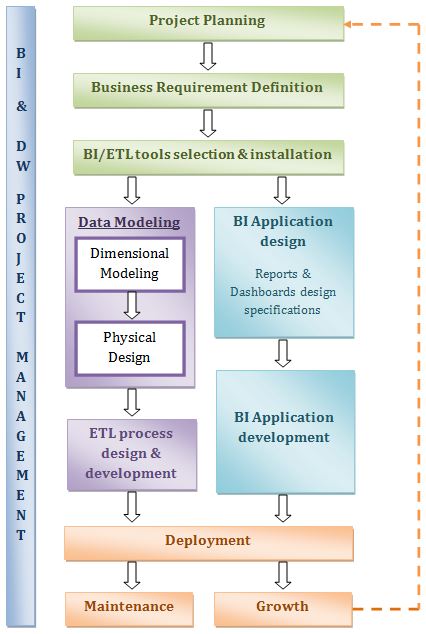Business Intelligence Project Lifecycle
Make data easy with Helical Insight.
Helical Insight is the world’s best open source business intelligence tool.
Project Planning
Project life cycle begins with project planning. Obviously, we must have a basic understanding of the business’s requirements to make appropriate scope decisions. Project planning then turns to resource staffing, coupled with project task identification, assignment, duration, and sequencing. The resulting integrated project plan identifies all tasks associated with the Lifecycle and the responsible parties.
Project Management
Project management ensures that the Project Lifecycle activities remain on track and in sync. Project management activities focus on monitoring project status, issue tracking, and change control to preserve scope boundaries. Ongoing management also includes the development of a comprehensive communication plan that addresses both the business and information technology (IT) constituencies. Continuing communication is critical to managing expectations; managing expectations is critical to achieving your DW/BI goals.
Business Requirement Definition
Business users and their requirements impact nearly every decision made throughout the design and implementation of a DW/BI system. From our perspective, business requirements sit at the centre of the universe, because they are so critical to successful data warehousing. Our understanding of the requirements influence most Lifecycle choices, from establishing the right scope, modeling the right data, picking the right tools, applying the right transformation rules, building the right analyses, and providing the right deployment support.
Product selection and installation
DW/BI environments require the integration of numerous technologies. Considering business requirements, technical environment, specific architectural components such as the hardware platform, database management system, extract-transformation-load (ETL) tool, or data access query and reporting tool must be evaluated and selected. Once the products have been selected, they are then installed and tested to ensure appropriate end-to-end integration within your DW/BI environment.
Data Modeling
Make data easy with Helical Insight.
Helical Insight is the world’s best open source business intelligence tool.
The first parallel set of activities following the product selection is the data track, from the design of the target dimensional model, to the physical instantiation of the model, and finally the “heavy lifting” where source data is extracted, transformed, and loaded into the target models.
Dimensional Modeling
During the gathering of business requirements, the organization’s data needs are determined and documented in a preliminary enterprise data warehouse representing the organization’s key business processes and their associated dimensionality. This matrix serves as a data architecture blueprint to ensure that the DW/BI data can be integrated and extended across the organization over time.
Designing dimensional models to support the business’s reporting and analytic needs requires a different approach than that used for transaction processing design. Following a more detailed data analysis of a single business process matrix row, modelers identify the fact table granularity, associated dimensions and attributes, and numeric facts.
Refer this link for more information on dimensional modeling process: http://helicaltech.com/dimensional-modeling-process/Physical Design
Physical database design focuses on defining the physical structures, including setting up the database environment and instituting appropriate security. Although the physical data model in the relational database will be virtually identical to the dimensional model, there are additional issues to address, such as preliminary performance tuning strategies, from indexing to partitioning and aggregations.
ETL Design & Development
Design and development of the extract, transformation, and load (ETL) system remains one of the most vexing challenges confronted by a DW/BI project team; even when all the other tasks have been well planned and executed, 70% of the risk and effort in the DW/BI project comes from this step.
BI Application Track
The next concurrent activity track focuses on the business intelligence (BI) applications.
BI application design
Immediately following the product selection, while some DW/BI team members are working on the dimensional models, others should be working with the business to identify the candidate BI applications, along with appropriate navigation interfaces to address the users’ needs and capabilities. For most business users, parameter driven BI applications are as ad hoc as they want or need. BI applications are the vehicle for delivering business value from the DW/BI solution, rather than just delivering the data.
BI application development
Following BI application specification, application development tasks include configuring the business metadata and tool infrastructure, and then constructing and validating the specified analytic and operational BI applications, along with the navigational portal.
Deployment
The 2 parallel tracks, focused on data and BI applications, converge at deployment. Extensive planning is required to ensure that these puzzle pieces are tested and fit together properly, in conjunction with the appropriate education and support infrastructure. It is critical that deployment be well orchestrated; deployment should be deferred if all the pieces, such as training, documentation, and validated data, are not ready for prime time release.
Maintenance
Make data easy with Helical Insight.
Helical Insight is the world’s best open source business intelligence tool.
Once the DW/BI system is in production, technical operational tasks are necessary to keep the system performing optimally, including usage monitoring, performance tuning, index maintenance, and system backup. We must also continue focus on the business users with ongoing support, education, and communication.
Growth
If we have done your job well, the DW/BI system is bound to expand and evolve to deliver more value to the business. Prioritization processes must be established to deal with the ongoing business demand. We then go back to the beginning of the Lifecycle, leveraging and building upon the foundation that has already been established, while turning our attention to the new requirements.
– Archana Verma

Best Open Source Business Intelligence Software Helical Insight is Here


